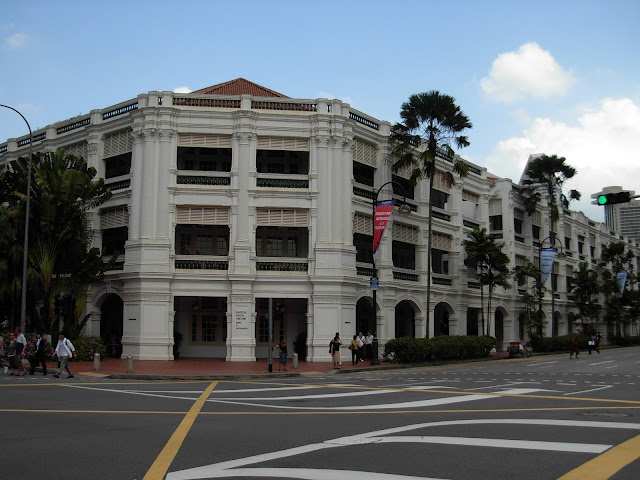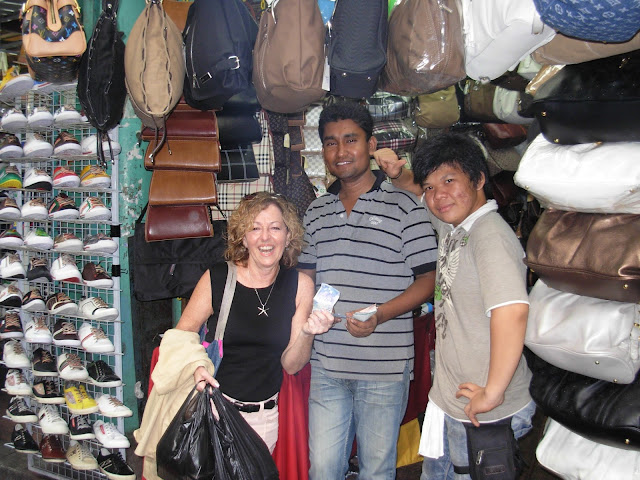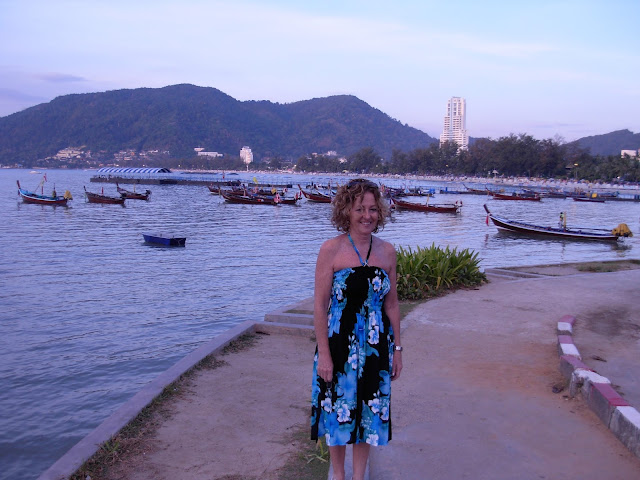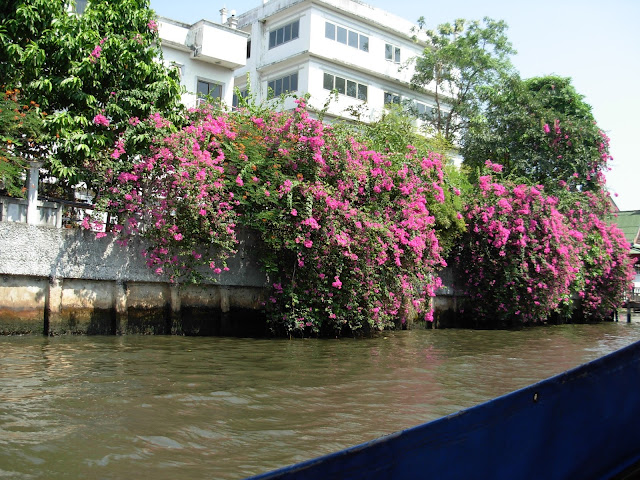
Southeast Asia, an area south of China, East of India and North of Australia, is a surprisingly harmonious blend of race, language, religion and culture that, like its food, is fascinating, colourful and occasionally spicy. In fact it was the spice trade developed by Arab traders that attracted the attention of Europeans in the 15th century, leading them to gradually annex the various territories with the Dutch moving into Indonesia, the Spanish into the Philippines, Britain into Burma and Malaysia and France into Cambodia, Laos and Vietnam. Only Thailand escaped colonial occupation.
First stop for us was the incredibly clean and well ordered city-state of Singapore At the centre of Southeast Asia, Singapore has been a bridge between East and West for centuries and today is the busiest port of the world, the 5th wealthiest country by GDP per person and ranked 10th highest in foreign currency reserves. First stop of course, after having flown across the Pacific, was the famous long bar at Raffles Hotel. Named after the modern founder of 1819, the signature drink is a “Singapore Sling” and, at $28.00 each, easily the most expensive cocktail I’ve ever had. But sitting in a comfortable wicker chair with a large fan above us to keep the air pleasantly cool, we quickly forgot about the inconvenience of flying and enjoyed the luxurious moment of civility and tradition.
The curious “Merlion” with its lions head and fish body is the
emblem of Singapore and is located in the centre of downtown where it is
surrounded by imaginative architecture, parks and waterways.
Not
far away is Chinatown and Little India, with the lively Bugis Street Village
shopping market in between. It was our
first taste of the incredible bargains to be had, particularly for clothing
and, with everything in Junie’s size, it was especially rewarding.
We
were especially fortunate to be in Southeast Asia at the time of the Lunar New
Year, and everywhere were lights and decorations promoting the Year of the
Tiger. Night time was a particularly
colourful time and, with the city being so safe and the weather so pleasant, it
was easy to see why the streets were crowded with people enjoying
themselves. With 74% of the population
Chinese it wasn’t hard to find a delicious Chinese dinner either.
While
Singapore laws may have many common elements of English common law they have
also chosen to ignore many liberal democratic values and regard activities such
as chewing gum, spitting, panhandling, and littering as criminal. There are no jury trials and, for persons
suspected of being members of a gang or terrorist group, they can be detained
without trial. There is freedom of
speech as long as you don’t say things that may breed ill will or cause
disharmony within the multi-racial multi-religious society. They still use corporal punishment (caning),
and the death penalty (hanging) is mandatory for murder, kidnapping, using
weapons and possession of or trafficking in drugs.
Singapore
law would certainly address nearly every irritant facing the people of
Vancouver and it would appear the citizens of Singapore have no intention of
giving up what they see as a very strong deterrent to anti-social
behaviour. Without worrying about crime
they can tend to their beautiful tree lined avenues and magnificent National Orchid
Garden with its more than 3,000 species.
Within minutes of crossing the causeway
from Singapore to Malaysia we encountered our first mosque and a reminder we
were now in a Muslim country with an arrow in every hotel room pointing to
Mecca. By law all ethnic Malays (which
make up 50% of the population) are Muslim but there is complete religious
freedom for the Chinese (24%), Indians (7%) and other ethnic groups who also
live here.
While on the surface it appears there is
full racial harmony, in the background, there are a number of policies and
double standards purposely discriminating against non-Malays that create
widespread resentment and envy. These
include the preferential treatment policies for education, housing and
employment as well as issues such as a non-Muslim person having to convert if
they were to marry a Muslim but the other way around being expressly forbidden.
However, the most immediate and striking
observation, as we drove along the excellent freeway, with its well stocked
rest-stops, were the endless miles of palm oil plantations that covered the
country-side. As far as the eye could
see, was the brilliant, lush, green of palm trees. A principal product of the Malaysian economy,
employing more than 500,000 people, and covering 4.5 million hectares, only
recently has it been overtaken by Indonesia as the world’s largest producer of
palm oil. The list of products using
palm oil is staggering, but it includes many things we use in our daily lives
including; soaps, food products, lubricants and bio-fuel. Even more interesting is that the palm tree
isn’t even native to Southeast Asia but it was introduced in 1848 to Indonesia
by the Dutch and in 1910 to Malaysia by the British.
First night’s stop was in Malacca, now a
quiet historical city that was once the centre of power in a Sultanate
controlling the Straits of Malacca. The
Portuguese were the first Europeans to take control of Malaysia and the ruins
of the old fort are a great place to take in the view after a tour around
Jonkers Street, the Cheng Hoon Temple and Stadthuys Square.
Before
the modern Muslim rules around Malay-Chinese intermingling, there was a long
standing history of inter-twined culture that produced a unique society known
as the Nyonya-Baba. To this day Malacca
tries to preserve this heritage in its museums and restaurants but, after all
the sightseeing, what I really needed was a good swim in our lovely hotel pool
with its view of the city.
Now we were off to Kuala Lumpur (or KL
as the locals say) the ultra modern capital city of Malaysia and the global
financial and insurance hub for the Islamic world. The landmark Petronas Twin Towers anchors a
downtown core that is bustling with people working, shopping, and eating 24
hours a day. The famous shopping centres
and mega malls of Bukit Bintang and Suria KLCC, interconnected with overhead
and underground walkways, are ample evidence the city has become an
international shopping destination as well.
But while these malls are also filled with a stunning variety of
restaurants, the real fun place to eat is out with the locals on Jalan Alor
Street.
The city also has a number of other
tourist attractions including the National Palace, National Museum and National
Monument sculpted by the same creator of the Iwo Jima monument in Washington.
Another
fascinating place to visit is the Genting Highlands Resort, a complex of
casinos and children’s theme parks that is accessible by a 3.5 km cable car
ride; the world’s fastest. Not much luck
with the roulette wheel but the view sure was great.
Reluctantly it was a time to say goodbye
to KL with all its lights and excitement and head into the Cameron Highlands
for something completely different, including the Malaysian Aboriginals (Orang
Asli) a people caught up in the wrong place and time as their traditional way
of life encounters all the complexities of the modern world.
The
Cameron Highlands, which are 5,000 feet above sea level, were discovered by the
English surveyor, William Cameron, on a mapping expedition. The British planters quickly realized its
potential for growing tea which it still does to this day, as well as other
fruits and vegetables. The cool mountain
air also makes it a favourite local tourist destination.
We also took some time to explore Kellies Castle, the sadly
never completed home of the Scottish rubber tycoon, and then admire the
magnificent Ubudiah Mosque. But after
all the sightseeing and tourist stuff it was time to put up our feet for a
couple of days, and what better spot than the beautiful beaches on the island
of Penang.
So
after crossing the 13.5 km Penang Bridge, one of the world’s longest, we
checked into our beachside hotel and I went for an ocean swim. However, it only lasted a few minutes
because, not having noticed the warning signs, I was immediately stung by a vicious
jellyfish. Once I recovered I had to
content myself with the hotel swimming pool which we also shared with a few Middle Eastern
Muslim women tourists wearing their burkas in the pool. The women were also confined to corners of the restaurant where they had to eat facing the wall. Very strange and unsettling from the point of view of a Westerner.
However, a missed connection to Thailand meant the airline had to put us up at a very nice hotel for the night which took some of the sting away and we didn't have to witness any further segregation of Muslim women in pools or restaurants.
The
next country to visit was Thailand “the land of smiles” and our first stop was
the island of Phuket and the ultra touristy beach of Patong Bay that was once
wiped out by the 2004 tsunami but quickly rebuilt. The streets and beach were crowded with ugly
tourists but they provided good business for all the Tuk-Tuk drivers, massage
parlours, bars and foreign food restaurants that had set up shop.
But
there was no denying the beauty of the ocean and, boarding a high speed boat, we raced to the nearby Phi
Phi islands for a wonderful day of snorkelling in the coral reefs, swimming in the clear, warm, blue water, and enjoying a tasty lunch.
In the Patpong district, go-go girl bars with names like Pretty Lady, Pussy Collection and Red Lips left no doubt as to what they were offering for entertainment. The only question was is it a boy or a girl? They were all so exotic and gorgeous and the sheer openness of it all was mind boggling. The prostitution capital of the world is a great place to be a man, but perhaps not such a great place for the girls or girly boys.
But
there is certainly more to Bangkok than its red-light district and the next
morning our guide was patiently showing us around the magnificent Buddhist
temples. Of particular interest was Wat
Trimit with its 13th century 5 ton solid gold Buddha that had only
been discovered in 1957 when it was accidently dropped during a move and the
plaster covering it fell away to reveal the gold underneath.
Other
places like the Grand Palace with its Wat Phra Kaeo temple of the Emerald
Buddha, or the Wat Pho temple of the
Reclining Buddha and its many Chedis, gave us the opportunity to
appreciate a little of the classic Thai architecture and their use of broken china to provide
the colourful and decorative touch that is so distinctive.

But
the most fun was getting into a private longboat for a rollicking cruise through the
canals and Chao Phraya River for a taste of “Venice of the East”. Dodging other
boats, while taking in the city sightlines, and seeing how the locals lived, was a perfect way to bring it all
together.


After a day in the country it was nice to get back to the bustle of the city with its street stalls, traffic chaos and a population that loved being out at night. Like KL it had massive shopping malls, efficient public transit and a made-in-Canada skytrain system. But what sets it apart from any other city are its Tuk-Tuks, the most delightful way of getting around and no two are ever the same.
When
you get to Vietnam the first thing you notice is the motor scooter. Purportedly the number one country in the
world for motorcycle use and, with a population of 84 million people who don’t
seem to use anything else, it certainly seems probable. The mass of riders provides an endless series
of photo opportunities especially when an entire family is on one bike and none
are wearing a helmet.

When we first arrived in Ho Chi Minh city, formerly known as Saigon, the main street was closed to traffic and Nguyen Hue Blvd. was beautifully decorated with floral arrangements for the Year of the Tiger celebrations.
Probably
no country has seared itself in the minds of North Americans like Vietnam with
all the images of the war that went on from 1964-1975. Of course the people themselves had been
fighting a war of independence against the French since 1945 when the Japanese
surrendered, and even after the Americans left there were still a few years of
conflict with Cambodia and China. To say
this country has suffered more than its fair share of war fatigue would be an
understatement yet the people seem to have put it all behind them now and are
totally focused on joining the modern capitalist world.
Nonetheless
the detritus of these wars, which is now on display, provides a fascinating
series of exhibits for tourists who quickly come to appreciate the ingenuity
and persistence of these people in fighting for their cause. The Dia Dao Cu Chi underground tunnel complex
is perhaps the most stunning example of how clever they had been in outsmarting
the Americans.

Flying
to Da Nang, an important port and the 3rd largest city in Vietnam,
provides the latest example of major changes being made to cash in on a growing
tourist trade. The area south of the
city, which was once a major American air force base during the war and the
busiest airport in the world with more than 2,000 take-offs and landings a day,
has now been cleared out and high end resorts are being built all the way to
the old city of Hoi An and beyond to take advantage of the stunning waterfront
and beautiful beaches.
Hoi
An itself is a pretty little town and one of the oldest cities in Southeast
Asia. An important port during the 15th
– 17th centuries it has been remarkably well preserved and is a
UNESCO heritage site.
The
road from Da Nang to Hue through the Pass of Mountain Clouds follows the
coastline and, besides stunning views of ocean and ubiquitous rice fields & water buffalo, it
also provides a real nail biting drive.
Hue itself, the old Imperial City and former capital, is filled with important historical buildings that must have bankrupted the local populace when they were constructed. The Forbidden Purple city was modelled after the Forbidden City in Beijing and, while it may not have had as many buildings, the walls and moat enclosed an even larger area. Unfortunately, much of the palace was bombed during the war but, now that it has been declared a UNESCO heritage site, restoration work on both it and the Royal Tombs has begun.
First
stop in Hanoi was the tomb of Ho Chi Minh, “Uncle Ho” to the people and still
revered by the thousands who line up every day to see him. There were a few more tourist attractions
like the infamous “Hanoi Hilton” to take in but having done all the war museum
stuff in Saigon, the pleasure here was in observing the French colonial
architecture and the lively, bustling streets of the “Old Quarter” where organized chaos seemed to be the norm.
Here
the food stalls, shops, and of course motor scooters, existed in a state of
continuous near collision but it was a fabulous place to eat, drink and people
watch. So was the nearby Hoan Kiem Lake,
a favourite hangout for families on the weekend.
Final
stop was incredible Hong Kong, a city so full of statistics that it’s hard to
know where to begin. With a population
of over 7 million it is one of the most densely populated places in the
world. One of the world’s leading
financial centres, it has the 6th largest stock exchange and is the
leading source of capital for IPO’s as well as being the largest re-export
centre. Architecturally speaking it’s
even more impressive, with more than 7,650 skyscrapers, the world’s most, 36 of
the world’s 100 tallest residential buildings, and more people working or
living above the 14th floor than anywhere on earth making it also the world’s
most vertical city. At night there is a
multi-coloured neon light show on the main office buildings and an endless
movement of people eating and shopping, which is all anyone seems to do here,
except of course work. With no social
safety net but very low taxes the people are incented to work hard but must look
after themselves.
Hong
Kong is not just the island of Hong Kong but also includes the mainland area
known as Kowloon and some other islands and land that make up the New
Territories. Victoria Harbour separates
Kowloon from Hong Kong Island and walking along the Avenue of Stars is the
first step for trying to take it all in.
While
of course you are free to walk and shop till you literally drop, (particularly
up and down the “Golden Mile” of Nathan Road and all the side streets with their infinite selection of shops) the city has the most incredible
transit system to take you anywhere you want with double-decker buses, the Star
Ferry service, and an extensive rapid transit system.
A couple of the favourite stops are the Stanley Market for some shopping and going on a sampan ride into the colourful Aberdeen Fishing Village with its floating restaurants and junks in the middle of all the high-rise buildings.
Best
of all is the panoramic view of the city from Victoria Peak where one can
contemplate all the high-rises and the staggering prices people pay for a
view and go for a cable car ride. It’s also interesting to observe
the role "feng shui" plays in the
design of some buildings.
But perhaps the most amazing discovery was the beautiful beaches on the back side of Hong Kong Island where development is minimal and the South China Sea is there for everyone to swim in. Repulse Bay is probably the most famous (though there are many others and they all are marked off with shark nets) and it was there I had the best swim of my holiday.
When
we started our trip we had hoped to gain a better understanding of the
Southeast Asian melting pot with its mixture of race, religion and
culture. What we discovered is there is
no melting pot and each country is very unique.
With wars and colonialism long in the past, the only thing everyone has
in common is a desire to prosper and succeed.
Globalization is the new mantra and, by the time we got to Hong Kong, we
could see that East and West had finally met and come to a perfect arrangement.


















































































































































































































No comments:
Post a Comment